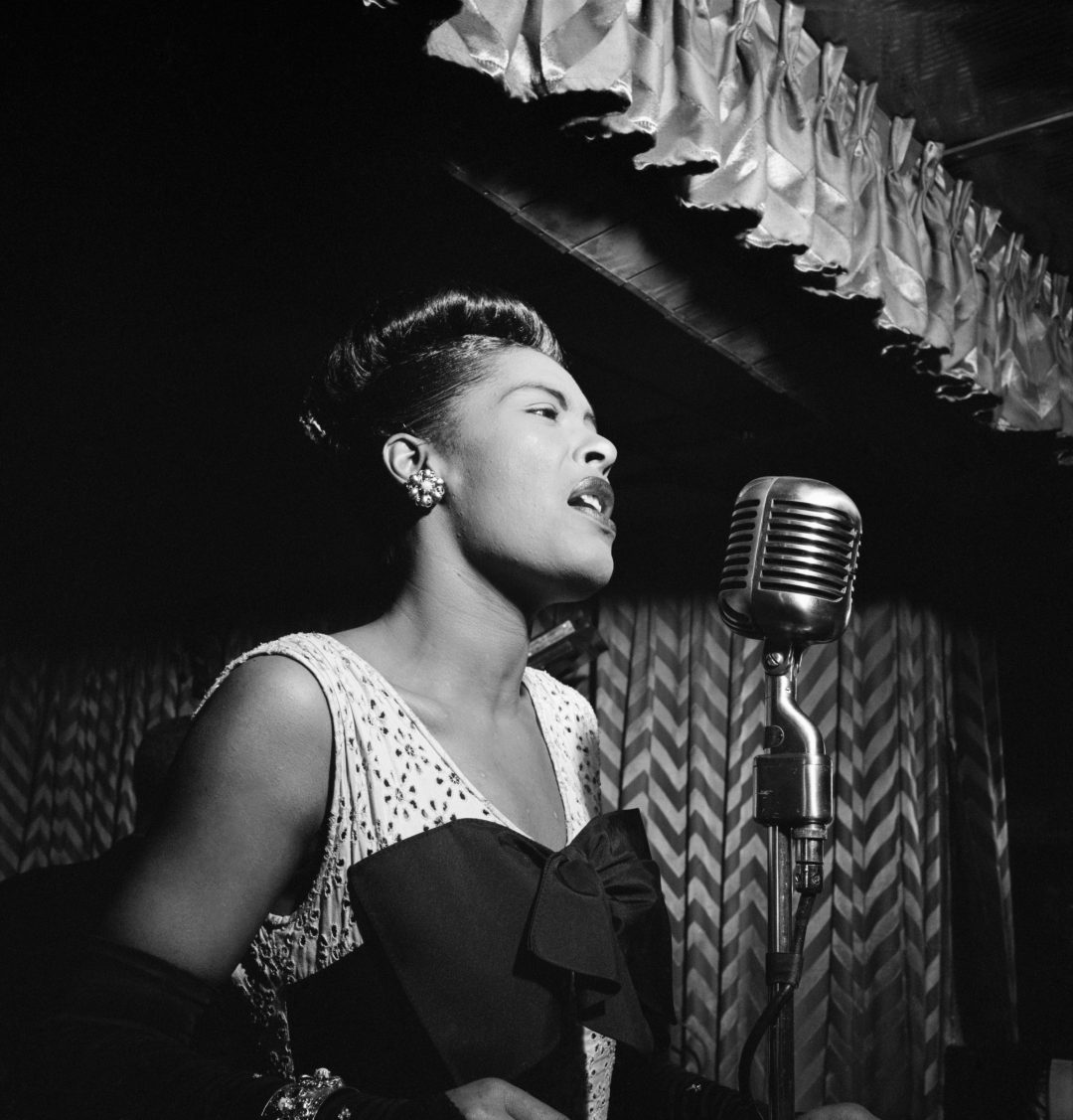“Strange Fruit,” recorded in 1939 by Billie Holiday, is one of the most well-known and powerful protest songs. Originally written as a poem in 1937 by Abel Meeropol (under the name Lewis Allan), it protested the lynching of Black Americans and systemic racism.[1] The song first came to Holiday’s attention while she was working at New York’s finest nightclub, Café Society.[2] After her first performance, People began to request “Stranger Fruit,” and it quickly became a part of Holiday’s routine.[3] When Holiday performed this song, it wasn’t just a written protest anymore; it became a call for justice.
The lyrics create a horrific picture: “Southern trees bear a strange fruit, blood on the leaves and blood at the root, Black bodies swinging in the Southern breeze.”[4] Holiday’s performance and Meeropol’s lyrics forced audiences to face the truth of racial violence. Samuel Perry explains that this use of imagery and engagement is a form of ekphrasis that makes the audience experience the lynching scene with all five senses.[5] Holiday and Meeropol broke the silence and comfort of racial violence that America had normalized.

Billie and her boxer dog, Mister, were an inseparable duo. Always by her side, Mister accompanied Billie to every performance (1947).
By the late 1930s, racial segregation and violence were deeply rooted in the South. While lynching was reported less often than in past decades (1890-1910)[6] it was still a horrific warning to anyone who challenged the racial order. As the United States prepared to enter World War II, the divide between fighting for democracy but denying it to so many at home was impossible to ignore. As David E. Shi explains in America: A Narrative History, “Although Americans found themselves fighting the racial bigotry celebrated by fascism and Nazism, the war did not end racism in the United States. Mississippi senator James Eastland spoke for racists everywhere when he declared at the start of the war that Black people “‘are an inferior race. They will not work. They will not fight’”.[7]
Singing this song was risky; it was a time when public acknowledgment of racial violence could easily make Holiday targeted.[8] The idea of defending freedom abroad but denying it to the “inferior race” makes Holiday’s performance even more important. She knew the need for justice, accountability, and action. As Samuel Ng writes, she had the talent, work ethic, and experience to be a “professional mourner,” using her personal pain and the pain of African Americans who lived in constant fear of racial violence. [9] During her live performances, the lights were dimmed, and a spotlight was focused on Holiday.[10] This setting had audiences focused on her voice, filled with strength and emotion. Ng explains how Holiday’s performance invited her audiences into “a feeling of shared vulnerability.”[11]

Portrait of Billie Holiday (1949).
Meeropol, who went to see her first performance, noted that Holiday sang “Strange Fruit” with conviction and understanding; ‘She gave a startling, most dramatic and effective interpretation, which could jolt an audience out of its complacency anywhere.” Holiday’s styling fulfilled the bitterness and shocking quality he hoped the song would have.[12] Holiday shapes individual words and whole phrases within the confidence of her own timing. For example, she shapes the word “I” to stand out, drawing close to her experiences and the imagery of racial violence.[13]
The song also ties into a longer history of confronting the legacy of lynching. As Amy Louise Wood and Susan Donaldson write, “when it comes to lynching, disagreements of representational or scholarly emphasis get waged over moral and political terrain.”[14] “Strange Fruit” entered that terrain by not turning away from the horror. Lynching was not only violence and a form of racial control; it was also a spectacle that shaped decades of the nation’s memory.[15] Holiday took back the narrative of Black suffering from a story of white control and turned it into resistance and remembrance. “Strange Fruit” inspired years of musicians and activists to use art and music not only as a form of resistance but as education. This is not just a song; it is a historical document that can be used to recognize the pain and resilience from America’s racial history.
[1] Liz Fields, “The Story behind Billie Holiday’s ‘Strange Fruit,’” PBS, (2021), https://www.pbs.org/wnet/billie-holidays-strange-fruit
[2] Fields, “The Story behind Billie Holiday’s ‘Strange Fruit’”.
[3] David Margolick, “Strange Fruit: Billie Holiday, Café Society, and An Early Cry for Civil Rights, 62.
[4] “Strange Fruit” performed by Billie Holiday (1959), lyrics by Lewis Allan (Abel Meeropol, 1937), https://www.youtube.com/watch?v=-DGY9HvChXk, accessed October 26, 2025.
[5] Samuel Perry, “‘Strange Fruit,’ Ekphrasis, and the Lynching Scene,” Rhetoric Society Quarterly 43, no. 5 (2013): 449–474, http://www.jstor.org/stable/24753578, accessed October 26, 2025.
[6] Tuskegee University Archives, “Lynchings Stats Year Dates Causes” (2021), https://law2.umkc.edu/faculty/projects/ftrials/shipp/lynchingyear.html
[7] David E. Shi, America: A Narrative History, 12th ed., vol. 2 (New York: W. W. Norton, 2022), 1164.
[8] Fields, “The Story behind Billie Holiday’s ‘Strange Fruit’”.
[9] Samuel G. Ng, “Professional Mourning: Billie Holiday’s ‘Strange Fruit’ and the Remaking of Black Consciousness,” The Journal of African American History 108, no. 4 (2023): 629–655, https://doi.org/10.1086/726667, accessed October 26, 2025.
[10] Fields, “The Story behind Billie Holiday’s ‘Strange Fruit’”.
[11] Ng, “Professional Mourning: Billie Holiday’s ‘Strange Fruit’ and the Remaking of Black Consciousness,” 630.
[12] Margolick, “Strange Fruit: Billie Holiday, Café Society, and An Early Cry for Civil Rights, 46.
[13] Kate Daubney, “Songbird or Subversive? Instrumental vocalisation technique in the songs of Billie Holiday”, Journal of Gender Studies, 11 (1): 25, https://doi.org/10.1080/09589230120115130
[14] Amy Louise Wood and Susan V. Donaldson, “Lynching’s Legacy in American Culture,” The Mississippi Quarterly 61, no. 1/2 (2008): 16, http://www.jstor.org/stable/26476641., accessed October 26, 2025.
[15] Wood and Donaldson, “Lynching’s Legacy in American Culture,” 5.
